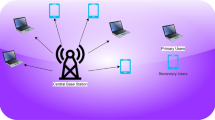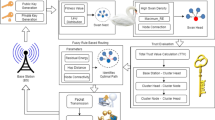Abstract
Spectrum utilization becomes more and more important while new communication techniques keep increasing and the spectrum bands remain finite. Cognitive radio is a revolutionary technology to make use of the spectrum more effectively. In order to avoid the interference to the primary user, spectrum sensing must be sensitive and reliable. Cooperative spectrum sensing (CSS) is one of the ways to increase the reliability of spectrum sensing. The information fusion technique is a key component of CSS. In this paper, we proposed a novel fusion scheme based on spatial correlation technique. We utilize geographical information with reputational weights to propose a two-level fusion scheme called secure centralized spectrum sensing (SCSS). The simulation results show that as the attackers present high density aggregation at some areas, the correct sensing ratio of SCSS is increasing as well even when the number of attackers is very large.













Similar content being viewed by others
References
Haykin, S. (2005). Cognitive radio: Brain-empowered wireless communications. IEEE Journal on Selected Areas in Communications, 23(2), 201–220.
Khozeimeh, F., & Haykin, S. (2009). Dynamic spectrum management for cognitive radio: An overview. Wireless Communications and Mobile Computing, 9(11), 1447–1459.
Kay, S. M. (1998). Fundamentals of statistical signal processing: Detection theory. Upper Saddle River, NJ: Prentice Hall.
Poor, H. V. (1994). An introduction to signal detection and estimation. New York: Springer.
Enserink, S., & Cochran, D. (1994). A cyclostationary feature detector. In Proceedings of 28th Asilomar conference on signals, systems, and computers, Pacific Grove, CA, Oct. 1994.
Akyildiz, I. F., Lee, W.-Y., Vuran, M. C., & Mohanty, S. (2006). NeXt generation/dynamic spectrum access/cognitive radio wireless networks: A survey. Computer Networks, 50(13), 2127–2159.
Chen, R., Park, J.-M., Hou, Y. T., & Reed, J. H. (2008). Toward secure distributed spectrum sensing in cognitive radio networks. IEEE Communications Magazine, 46(4), 50–55.
Chen, R., Park, J.-M., & Bian, K. (2008). Robust distributed spectrum sensing in cognitive radio networks. In Proceedings of IEEE Infocom 2008 mini-conference, April 2008.
Varshney, P. K. (1997). Distributed detection and data fusion. New York: Springer.
Sun, H., Laurenson, D. I., Thompson, J., & Wang, C.-X. (2008). A novel centralized network for sensing spectrum in cognitive radio. In Proceedings of IEEE International Conference Communications, ICC 2008, Beijing, China, 19–23 May, 2008.
Bettstetter, C., Resta, G., & Santi, P. (2003). The node distribution of the random waypoint mobility model for wireless ad hoc networks. IEEE Transactions Mobile Computing, 2(3), 257–269.
Hata, M. (1980). Empirical formula for propagation loss in land mobile radio services. IEEE Transaction Vehicular Technology, VT-29, 317–325.
Visotsky, E., Kuffner, S., & Peterson, R. (2005). On collaborative detection of TV transmissions in support of dynamic spectrum sharing. In Proceedings IEEE DySPAN, Nov. 2005, pp. 338–345.
Lu, L., Chang, S.-Y., Zhang, J., Qian, L., Wen, J., Lau, V. K. N., Cheng, R. S., Murch, R. D., Mow, W. H., & Letaief, K. B. (2006). Technology Proposal Clarifications for IEEE 802.22 WRAN Systems, Mar. 2006.
Hillenbrand, J., Weiss, T. A., & Jondral, F. K. (2005). Calculation of detection and false alarm probabilities in spectrum pooling systems. IEEE Communications Letters, 9(4), 349–351.
Mitola III, J. (2000). Cognitive radio: An integrated agent architecture for software defined radio, Ph.D. Thesis, KTH Royal Institute of Technology, 2000.
Chen, C.-Y., Chou, Y.-H., Chao, H.-C., & Lo, C.-H. (2010). Toward secure centralized spectrum sensing by utilizing geographical information. The 5th International Conference on Future Information Technology (FutureTech 2010), Busan, Korea, May 21–23, 2010.
Wassim, E., Haidar, S., & Mohsen, G. (2011). Survey of security issues in cognitive radio networks. Journal of Internet Technology, 12(2), 181–198.
Penna, F., & Garello, R. (2011). Detection of discontinuous signals for cognitive radio applications. IET Communications, 5(10), 1453–1461.
Shen, J., Liu, S., Zeng, L., Xie, G., Gao, J., & Liu, Y. (2009). Optimisation of cooperative spectrum sensing in cognitive radio network. IET Communications, 3(7), 1170–1178.
Acknowledgments
The authors acknowledge Kuan-Cheng Ho for his contributions to the simulations. This research was partly funded by the National Science Council of the ROC under grants NSC 99-2219-E-197-001 and NSC 99-2219-E-197-002.
Author information
Authors and Affiliations
Corresponding author
Rights and permissions
About this article
Cite this article
Chen, CY., Chou, YH., Chao, HC. et al. Secure centralized spectrum sensing for cognitive radio networks. Wireless Netw 18, 667–677 (2012). https://doi.org/10.1007/s11276-012-0426-3
Published:
Issue Date:
DOI: https://doi.org/10.1007/s11276-012-0426-3




